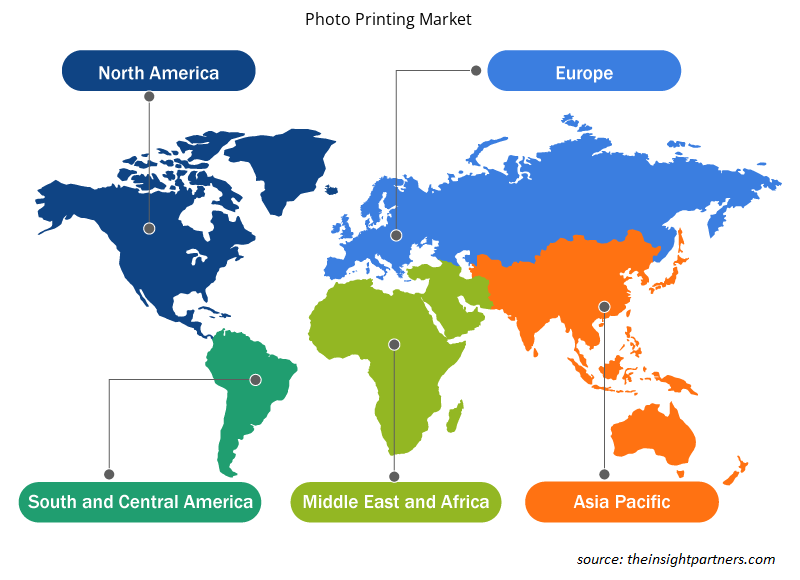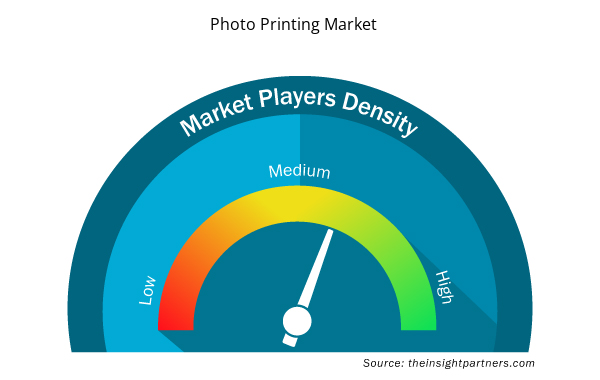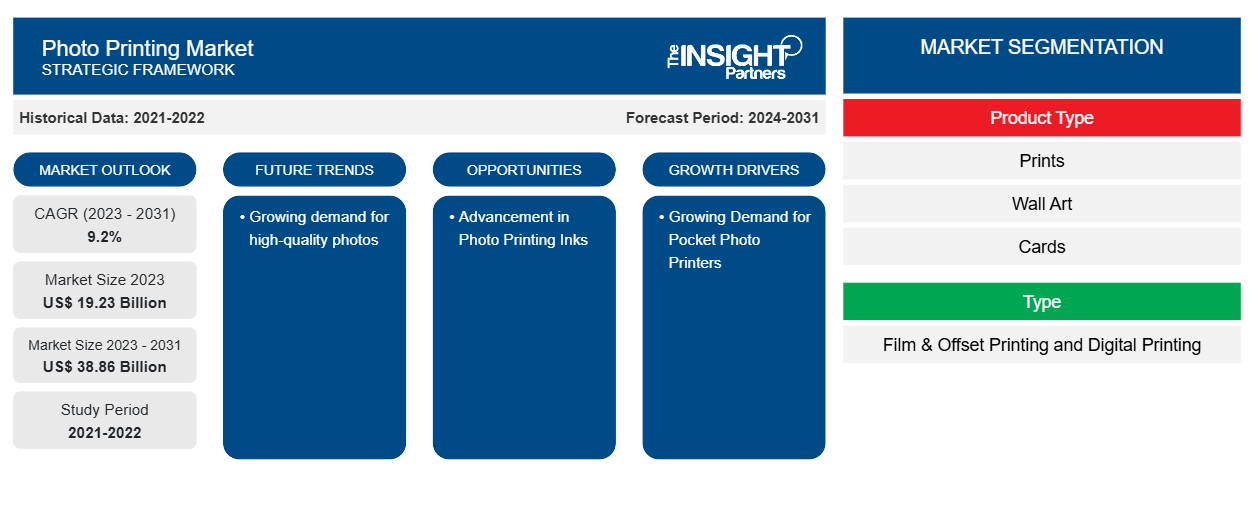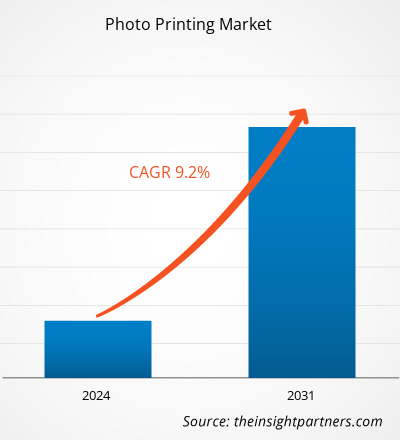Si prevede che la dimensione del mercato della stampa fotografica raggiungerà i 19,23 miliardi di dollari entro il 2031, rispetto ai 38,86 miliardi di dollari del 2023. Si prevede che il mercato registrerà un CAGR del 9,2% nel 2023-2031. È probabile che la crescente domanda di foto di alta qualità rimanga una tendenza chiave del mercato della stampa fotografica.CAGR of 9.2% in 2023–2031. Growing demand for high-quality photos is likely to remain a key photo printing market trend.
Analisi della stampa fotografica
Il mercato della stampa fotografica sta crescendo a un ritmo rapido a causa della crescente domanda di stampanti fotografiche tascabili e della crescente richiesta da parte dei consumatori di stampe fotografiche uniche e personalizzate. Il mercato si sta espandendo costantemente, spinto dalla crescente domanda di tecnologie di stampa eco-compatibili. Inoltre, i progressi negli inchiostri per la stampa fotografica e la crescente domanda di stampa senza inchiostro stanno offrendo opportunità redditizie per la crescita del mercato. eco-friendly printing technologies. Moreover, advancements in photo printing inks and the increasing demand for inkless printing is providing lucrative opportunities for market growth.
Panoramica del mercato della stampa fotografica
La stampa fotografica si riferisce a un processo che converte le informazioni digitali, come immagini o video, in stampe tangibili che vengono esposte in vetrine, mostre e display. Questo processo prevede l'uso di una stampante fotografica per trasferire immagini digitali o stampe scansionate su carta o altri materiali. Le stampanti fotografiche sono principalmente progettate e utilizzate per generare stampe di alta qualità con colori accurati e dettagli precisi. Esistono numerose tecniche di stampa, come carta , metallo e tela, utilizzate per la stampa fotografica.
Personalizza questo report in base alle tue esigenze
Riceverai la personalizzazione gratuita di qualsiasi report, comprese parti di questo report, o analisi a livello nazionale, pacchetto dati Excel, oltre a usufruire di grandi offerte e sconti per start-up e università
- Scopri le principali tendenze di mercato in questo rapporto.Questo campione GRATUITO includerà analisi di dati che spaziano dalle tendenze di mercato alle stime e alle previsioni.
Driver e opportunità del mercato della stampa fotografica
La crescente domanda di stampanti fotografiche tascabili sta guidando il mercato
Le stampanti fotografiche tascabili hanno guadagnato popolarità negli ultimi anni. Queste stampanti sono portatili e solitamente si collegano a telefoni o altri dispositivi tramite Bluetooth, consentendo agli utenti di stampare da qualsiasi luogo. Le stampanti fotografiche tascabili sono incredibilmente utili nella vita di tutti i giorni, specialmente per i professionisti creativi. Inoltre, la crescente industria dei viaggi e del turismo aumenta l'adozione di stampanti fotografiche tascabili tra i viaggiatori, dando una spinta al mercato.
Progressi negli inchiostri per la stampa fotografica
La tecnologia di stampa ha fatto notevoli progressi nello sviluppo di inchiostri specificamente progettati per la fotografia paesaggistica (o qualsiasi immagine). Produttori come Epson, Canon e HP hanno aperto la strada alla creazione di inchiostri a base di pigmenti che producono stampe incredibilmente brillanti e durature. Questi inchiostri sono composti da particelle microscopiche che galleggiano in una base liquida, offrendo una gamma di colori più ampia e una migliore resistenza allo sbiadimento rispetto agli inchiostri a base di coloranti. Ad esempio, Epson, nota per la sua tecnologia PrecisionCore, potrebbe aver stabilito uno standard di settore con i suoi inchiostri UltraChrome Pro. Gli inchiostri a base di pigmenti migliorano la consistenza della lucentezza e riducono l'effetto bronzato, conferendo un aspetto ancora più liscio e raffinato.PrecisionCore technology, may have set an industry standard with its UltraChrome Pro inks. Pigment-based inks improve gloss consistency and decrease bronzing, giving an even smoother and more refined appearance.
Analisi della segmentazione del rapporto sul mercato della stampa fotografica
I segmenti chiave che hanno contribuito alla derivazione dell'analisi del mercato della stampa fotografica sono il tipo di prodotto, la tipologia e il canale di distribuzione.
- In base al tipo di prodotto, il mercato della stampa fotografica è suddiviso in stampe, arte murale, biglietti, regali fotografici, libri fotografici, calendari e altri. Il segmento delle stampe ha detenuto una quota di mercato maggiore nel 2023.
- In base al tipo, il mercato della stampa fotografica è suddiviso in stampa offset e su pellicola e stampa digitale. Il segmento della stampa digitale ha detenuto una quota di mercato maggiore nel 2023.
- In termini di canale di distribuzione, il mercato è segmentato in vendita al dettaglio, online e chiosco istantaneo. Il segmento online ha detenuto la quota maggiore del mercato nel 2023.
Analisi della quota di mercato della stampa fotografica per area geografica
L'ambito geografico del rapporto sul mercato della stampa fotografica è suddiviso principalmente in cinque regioni: Nord America, Asia Pacifico, Europa, Medio Oriente e Africa e Sud America/Sud e Centro America.
In termini di fatturato, il Nord America ha rappresentato la quota di mercato più grande per la stampa fotografica. Il mercato in questa regione è segmentato in Stati Uniti, Canada e Messico. Il crescente utilizzo della fotografia digitale per scopi personali sta guidando il mercato. La crescente digitalizzazione e il crescente utilizzo di smartphone tra i consumatori per catturare e condividere foto stanno guidando il mercato durante il periodo di previsione.
Approfondimenti regionali sul mercato della stampa fotografica
Le tendenze regionali e i fattori che influenzano il mercato della stampa fotografica durante il periodo di previsione sono stati ampiamente spiegati dagli analisti di Insight Partners. Questa sezione discute anche i segmenti e la geografia del mercato della stampa fotografica in Nord America, Europa, Asia Pacifico, Medio Oriente e Africa e America meridionale e centrale.

- Ottieni i dati specifici regionali per il mercato della stampa fotografica
Ambito del rapporto sul mercato della stampa fotografica
| Attributo del report | Dettagli |
|---|---|
| Dimensioni del mercato nel 2023 | 19,23 miliardi di dollari USA |
| Dimensioni del mercato entro il 2031 | 38,86 miliardi di dollari USA |
| CAGR globale (2023-2031) | 9,2% |
| Dati storici | 2021-2022 |
| Periodo di previsione | 2024-2031 |
| Segmenti coperti | Per tipo di prodotto
|
| Regioni e Paesi coperti | America del Nord
|
| Leader di mercato e profili aziendali chiave |
|
Densità degli attori del mercato: comprendere il suo impatto sulle dinamiche aziendali
Il mercato della stampa fotografica sta crescendo rapidamente, spinto dalla crescente domanda degli utenti finali dovuta a fattori quali l'evoluzione delle preferenze dei consumatori, i progressi tecnologici e una maggiore consapevolezza dei vantaggi del prodotto. Con l'aumento della domanda, le aziende stanno ampliando le loro offerte, innovando per soddisfare le esigenze dei consumatori e capitalizzando sulle tendenze emergenti, il che alimenta ulteriormente la crescita del mercato.
La densità degli operatori di mercato si riferisce alla distribuzione di aziende o società che operano in un particolare mercato o settore. Indica quanti concorrenti (operatori di mercato) sono presenti in un dato spazio di mercato in relazione alle sue dimensioni o al valore di mercato totale.
Le principali aziende che operano nel mercato della stampa fotografica sono:
- Società Fujifilm
- Adorama Camera, Inc.
- Laboratorio fotografico della baia
- Società a responsabilità limitata
- Laboratorio fotografico delle Nazioni
- La Walgreens Co.
Disclaimer : le aziende elencate sopra non sono classificate secondo un ordine particolare.

- Ottieni una panoramica dei principali attori del mercato della stampa fotografica
Notizie e sviluppi recenti sul mercato della stampa fotografica
Il mercato della stampa fotografica viene valutato raccogliendo dati qualitativi e quantitativi dopo la ricerca primaria e secondaria, che includono importanti pubblicazioni aziendali, dati associativi e database. Di seguito è riportato un elenco degli sviluppi nel mercato della stampa fotografica e delle strategie:
- A luglio 2022, Canon Inc ha annunciato la SELPHY CP1500, una nuova stampante fotografica compatta wireless facile da usare che promette di deliziare con stampe personalizzate e di alta qualità. La SELPHY CP1500 migliora ulteriormente la vividezza delle stampe di ritratti. Oltre all'uso della tecnologia di sublimazione del colore, che consente toni di colore più uniformi e gradazioni più ricche, la SELPHY PRINTER CP 1500 è dotata di una funzione di correzione automatica che regola luminosità, saturazione, contrasto e toni nelle immagini per una finitura migliore e più chiara. (Fonte: Canon Inc, comunicato stampa, 2022)
Copertura e risultati del rapporto sul mercato della stampa fotografica
Il rapporto "Dimensioni e previsioni del mercato della stampa fotografica (2023-2031)" fornisce un'analisi dettagliata del mercato che copre le seguenti aree:
- Dimensioni e previsioni del mercato a livello globale, regionale e nazionale per tutti i segmenti di mercato chiave coperti dall'ambito
- Dinamiche di mercato come fattori trainanti, vincoli e opportunità chiave
- Principali tendenze future
- Analisi dettagliata delle cinque forze PEST/Porter e SWOT
- Analisi di mercato globale e regionale che copre le principali tendenze di mercato, i principali attori, le normative e gli sviluppi recenti del mercato
- Analisi del panorama industriale e della concorrenza che copre la concentrazione del mercato, l'analisi della mappa di calore, i principali attori e gli sviluppi recenti
- Profili aziendali dettagliati
- Analisi storica (2 anni), anno base, previsione (7 anni) con CAGR
- Analisi PEST e SWOT
- Valore/volume delle dimensioni del mercato - Globale, regionale, nazionale
- Industria e panorama competitivo
- Set di dati Excel



Report Coverage
Revenue forecast, Company Analysis, Industry landscape, Growth factors, and Trends

Segment Covered
This text is related
to segments covered.

Regional Scope
North America, Europe, Asia Pacific, Middle East & Africa, South & Central America

Country Scope
This text is related
to country scope.
Domande frequenti
The global photo printing market was estimated to be US$ 19.23 billion in 2023 and is expected to grow at a CAGR of 9.2% during the forecast period 2023 - 2031.
Growing demand for pocket photo printers and the rising consumer requirement for unique and customized photo prints are the major factors that propel the global photo printing market.
Growing demand for high-quality photos is anticipated to play a significant role in the global photo printing market in the coming years.
The key players holding majority shares in the global photo printing market are Fujifilm Corporation, Adorama Camera, Inc., Bay Photo Lab, Digitalab Ltd., and Nations Photo Lab.
The global photo printing market is expected to reach US$ 38.86 billion by 2031.
The incremental growth expected to be recorded for the global photo printing market during the forecast period is US$ 19.63 billion.
Trends and growth analysis reports related to Electronics and Semiconductor : READ MORE..
The Insight Partners performs research in 4 major stages: Data Collection & Secondary Research, Primary Research, Data Analysis and Data Triangulation & Final Review.
- Data Collection and Secondary Research:
As a market research and consulting firm operating from a decade, we have published and advised several client across the globe. First step for any study will start with an assessment of currently available data and insights from existing reports. Further, historical and current market information is collected from Investor Presentations, Annual Reports, SEC Filings, etc., and other information related to company’s performance and market positioning are gathered from Paid Databases (Factiva, Hoovers, and Reuters) and various other publications available in public domain.
Several associations trade associates, technical forums, institutes, societies and organization are accessed to gain technical as well as market related insights through their publications such as research papers, blogs and press releases related to the studies are referred to get cues about the market. Further, white papers, journals, magazines, and other news articles published in last 3 years are scrutinized and analyzed to understand the current market trends.
- Primary Research:
The primarily interview analysis comprise of data obtained from industry participants interview and answers to survey questions gathered by in-house primary team.
For primary research, interviews are conducted with industry experts/CEOs/Marketing Managers/VPs/Subject Matter Experts from both demand and supply side to get a 360-degree view of the market. The primary team conducts several interviews based on the complexity of the markets to understand the various market trends and dynamics which makes research more credible and precise.
A typical research interview fulfils the following functions:
- Provides first-hand information on the market size, market trends, growth trends, competitive landscape, and outlook
- Validates and strengthens in-house secondary research findings
- Develops the analysis team’s expertise and market understanding
Primary research involves email interactions and telephone interviews for each market, category, segment, and sub-segment across geographies. The participants who typically take part in such a process include, but are not limited to:
- Industry participants: VPs, business development managers, market intelligence managers and national sales managers
- Outside experts: Valuation experts, research analysts and key opinion leaders specializing in the electronics and semiconductor industry.
Below is the breakup of our primary respondents by company, designation, and region:

Once we receive the confirmation from primary research sources or primary respondents, we finalize the base year market estimation and forecast the data as per the macroeconomic and microeconomic factors assessed during data collection.
- Data Analysis:
Once data is validated through both secondary as well as primary respondents, we finalize the market estimations by hypothesis formulation and factor analysis at regional and country level.
- Macro-Economic Factor Analysis:
We analyse macroeconomic indicators such the gross domestic product (GDP), increase in the demand for goods and services across industries, technological advancement, regional economic growth, governmental policies, the influence of COVID-19, PEST analysis, and other aspects. This analysis aids in setting benchmarks for various nations/regions and approximating market splits. Additionally, the general trend of the aforementioned components aid in determining the market's development possibilities.
- Country Level Data:
Various factors that are especially aligned to the country are taken into account to determine the market size for a certain area and country, including the presence of vendors, such as headquarters and offices, the country's GDP, demand patterns, and industry growth. To comprehend the market dynamics for the nation, a number of growth variables, inhibitors, application areas, and current market trends are researched. The aforementioned elements aid in determining the country's overall market's growth potential.
- Company Profile:
The “Table of Contents” is formulated by listing and analyzing more than 25 - 30 companies operating in the market ecosystem across geographies. However, we profile only 10 companies as a standard practice in our syndicate reports. These 10 companies comprise leading, emerging, and regional players. Nonetheless, our analysis is not restricted to the 10 listed companies, we also analyze other companies present in the market to develop a holistic view and understand the prevailing trends. The “Company Profiles” section in the report covers key facts, business description, products & services, financial information, SWOT analysis, and key developments. The financial information presented is extracted from the annual reports and official documents of the publicly listed companies. Upon collecting the information for the sections of respective companies, we verify them via various primary sources and then compile the data in respective company profiles. The company level information helps us in deriving the base number as well as in forecasting the market size.
- Developing Base Number:
Aggregation of sales statistics (2020-2022) and macro-economic factor, and other secondary and primary research insights are utilized to arrive at base number and related market shares for 2022. The data gaps are identified in this step and relevant market data is analyzed, collected from paid primary interviews or databases. On finalizing the base year market size, forecasts are developed on the basis of macro-economic, industry and market growth factors and company level analysis.
- Data Triangulation and Final Review:
The market findings and base year market size calculations are validated from supply as well as demand side. Demand side validations are based on macro-economic factor analysis and benchmarks for respective regions and countries. In case of supply side validations, revenues of major companies are estimated (in case not available) based on industry benchmark, approximate number of employees, product portfolio, and primary interviews revenues are gathered. Further revenue from target product/service segment is assessed to avoid overshooting of market statistics. In case of heavy deviations between supply and demand side values, all thes steps are repeated to achieve synchronization.
We follow an iterative model, wherein we share our research findings with Subject Matter Experts (SME’s) and Key Opinion Leaders (KOLs) until consensus view of the market is not formulated – this model negates any drastic deviation in the opinions of experts. Only validated and universally acceptable research findings are quoted in our reports.
We have important check points that we use to validate our research findings – which we call – data triangulation, where we validate the information, we generate from secondary sources with primary interviews and then we re-validate with our internal data bases and Subject matter experts. This comprehensive model enables us to deliver high quality, reliable data in shortest possible time.


 Ottieni un campione gratuito per questo repot
Ottieni un campione gratuito per questo repot